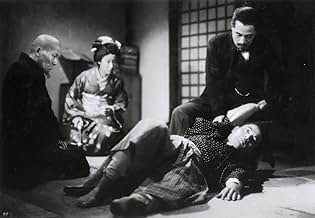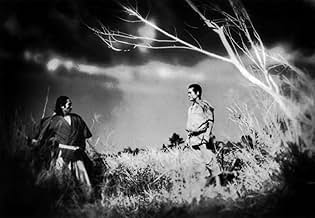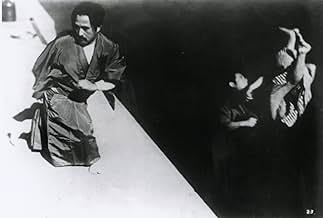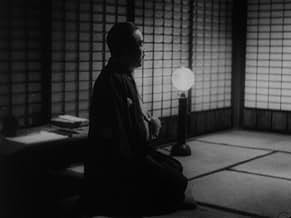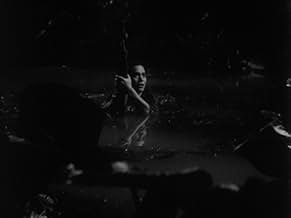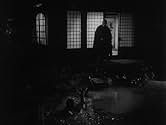Aggiungi una trama nella tua linguaSugata, a young man, struggles to learn the nuance and meaning of judo, and in doing so comes to learn something of the meaning of life.Sugata, a young man, struggles to learn the nuance and meaning of judo, and in doing so comes to learn something of the meaning of life.Sugata, a young man, struggles to learn the nuance and meaning of judo, and in doing so comes to learn something of the meaning of life.
- Regia
- Sceneggiatura
- Star
- Hatta
- (as Michisaburo Segawa)
- Monma's pupil
- (non citato nei titoli originali)
Recensioni in evidenza
Having said that, you will find this to be one of Kurasawa's most interesting projects. Two things...
One is that this was made by the bad guys during the war. Incredible atrocities were being committed in the name of racial superiority and the supposition of a refined nobility. Japanese, German and American films (even Italian ones) turned to reinforcing the national character. In the Japanese case, that was linked to matters of honor refracted through Shinto spirituality, honor of a past ideal that never really existed, which in US terms means what "conservatives" tout.
It was a terrible exercise, more obvious in looking at it from the outside and knowing the context. Kurosawa's story was every bit as engineered for this purpose as any Reifenstahl project. Oddly, this film is fragmented because the sensors thought it not ennobling enough. One presumes that Kurosawa's moments of reflection, and possibly a whole love story, were among the half of the movie that was removed. So just on the level of the story itself (a modernized samurai tale), its of interest.
But it IS Kurasawa, so we have to pay attention to the way the camera engages with the space. This is his very first film as director, though he had written before. In all his films he registers the camera first in a space and then allows action to happen in that space. He has three periods of different types of spatial identity, each illuminating, each inventing new language. But this is before all that and what we have is clear, overt experimentation with space. Some of it is quite thrilling, quite independent of the fascist movement of the story proper.
Even here, he is breaking the rules of flat Japanese composition from eons of painting. He was considered unJapanese in his native country and never very popular. So at the same time that those censors were chopping story and posture they must have been shaking their heads at this three dimensional art, and wondering if they had already lost the war and if they won, what for?
Ted's Evaluation -- 3 of 3: Worth watching.
The outstanding, mind-blowing camera-work that Kurosawa is known for is in a huge development process here, on account of this being his first work; however, even though not yet in a full-fledged form, everything that is meant to be portrayed comes through wonderfully. The story is another factor that definitely enhances the representation taking place in the film, as it matches perfectly with the cinematic techniques Kurosawa puts to work. If there are any inconveniences to be encountered throughout the course of the film, it would all obviously be as a result of the cut-off already mentioned.
The conspicuous acting goes without saying; everyone in the film fits into their roll perfectly. The main character may probably come as overacted to an audience not familiarized with Kurosawa's work, or Japanese cinema for that matter; Susuma Fujita would not be as well-known as Toshiro Mifune would later become, but he undoubtedly does his best here.
The film, despite the cut-off, works perfectly. One can just wonder how much better this could be if it were in its full form, as first conceived by the director.
There are little notes to take for Kurosawa fans, little things that will give many a grin and even a laugh at what pops up: the classic "wipes" as means of scene transitions; the usage of slow-motion during an action/fight sequence, in this case at the end of a fight as the opponent conks out and the flag (this part in slow-motion) falls to the ground; Takashi Shimura, who appeared in more Kurosawa films than Mifune, as one of Sugata's opponents, who's a tough cookie but a fair fight who at the end gives Sugata praise as a great fighter; symbolism in usage of the sky, flowers, and other Earthly means as a way to communicate the environment of a scene, and a specific nature about it, as much as the characters in it. All the same, this is not to say that Sanshiro Sugata is exactly a masterwork right off the bat for the 32 year old filmmaker; the use of certain symbols, like when Sugata is in the mucky pond trying to have his own form of penance and snaps out of it once seeing a flower right in front of his face, isn't really as effective as intended and comes off as more of a cliché than anything else. The subplot with Sugata and the daughter is undercooked as romance, even as brief as it is. And the fact that the film now stands as missing 17 minutes is a hindrance; one has to comment on what remains as opposed to what could have been a complete work from Kurosawa (not as detrimental as the Idiot, but still bothersome all the same as in the title-card transitions).
But as an act of passionate action film-making, it stands its ground some 60+ years later in containing some intense scenes involving Sugata's training (I liked seeing Sugata coming face to face with a man who wants to challenge his boss, and dressed in more Western garb than anyone else in the film), and more specifically the actual fight scenes. While its a given that Kurosawa is a pro at getting down stubborn men- and professional traditionalist men for that matter- getting down and dirty and violent, it's impressive in hindsight from the rest of his career that he could add tension just by tilting the camera up during the street-fight, or in staying on the faces of the fighters, and numerous reaction shots, during the fights in the arena area. The Shimura fight especially has an aura of being as thrilling as a modern fight sequence, with aforementioned humanity coming through with every pummel and thrust and toss-up of one character over another. This all leads up to the climax, which is not only a highlight of the film but a highlight in the history of classic Japanese action sequences, as we see Kurosawa already relying on the sky, the grass pushed and pulled by wind, and the compassion of the others around the two opponents (the old man and the girl) as a fight to the death, seen mostly out of sight through the grass, proceeds intensely more due to the intent and emotion of the characters than traditional stunts and fast-pace editing.
Sanshiro Sugata is a worthy production in the cinematic cannon of Kurosawa, acting as a very good stand-alone effort for genre fans while speaking to his practically intuitive cinematic strengths at controlling the pace of a scene and meaning via certain visual cues and enjoyable performances garnered by the pro actors. It does show some of its age, and along with the cuts made in the only version available today (in a print, by the way, that is rather horrid considering who the director is) it had to face some given restrictions due to Japan's censorship laws, but it's also a cunning display of a debut showcasing the talents of a confident director in a film that was meant to be seen by a mass audience, if only for diversion during the war.
Lo sapevi?
- QuizWhen asked about his experience filming his debut movie, Akira Kurosawa said "I simply enjoyed it. I went to sleep each night looking forward eagerly to the next day's shooting, and there was absolutely nothing painful in the experience... the whole task was carried out with a feeling of ease."
- Citazioni
Sanshiro Sugata: The spirits of heaven and earth congregate in our nation of gods. For us they have built Mt. Fuji that towers for eternity. For us they have brought water to flow around our islands. For us they have created the beauty of cherry blossoms...
[he stops and remembers Sayo]
Buddhist Priest: [hits Sanshiro on the head] Idiot! This is an important match. What the hell are you thinking?
Sanshiro Sugata: I can't do it. I can't win.
Buddhist Priest: What? Are you afraid of Hansuke Murai?
Sanshiro Sugata: No. Someone stands between him and me.
Buddhist Priest: Who?
Sanshiro Sugata: His daughter.
Buddhist Priest: You love her?
Sanshiro Sugata: No. It's not that. Priest, I saw her praying selflessly for her father. It was beautiful and I was touched. That's the problem. How can I overcome it?
Buddhist Priest: Stupid! Be pure and innocent like her.
Sanshiro Sugata: I can't.
Buddhist Priest: You can. You once were.
Sanshiro Sugata: When?
Buddhist Priest: [pointing to the pond] Sanshiro Sugata found new life there. Have you forgotten? What is your life, Sanshiro?
- Versioni alternativeAlthough originally released in Japan at 97 minutes, it was re-edited and re-released in Japan in 1952 at 80 minutes. This 80-minute version is all that is currently available, and it includes some slight changes in the film's structure as well as its running time.
- ConnessioniFeatured in Kurosawa: The Last Emperor (1999)
I più visti
- How long is Sanshiro Sugata?Powered by Alexa
Dettagli
- Tempo di esecuzione1 ora 19 minuti
- Colore
- Mix di suoni
- Proporzioni
- 1.37 : 1
Contribuisci a questa pagina


